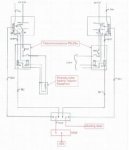I've raised this question before, but didn't seem to generate a lot of notice so I'll try and ask it again based on new information found. I've attached a one-line to provide a visual of the installation.
A contractor has taken a GEC from each of two (2) dry-type transformers both located in a telecommunications room, to a telecommunications ground bar (TMGB). Each dry type XFMR (480-208/120) feeds a power panel serving telecom loads; each power panel per TIA-607-A is required to have a bonding jumper to the TMGB. The same TMGB is also required (per the same TIA standard) to bond to building steel and in my interpretation is to be used for telecommunications equipment bonding only. The TMGB is then is then bonded to a Main Ground Bar via 4/0AWG located in another room, with the MGB designed as the common connection point for each grounding electrode defined under 250.52, which is allowed per 250.30(A)(6), 250.64(D)(1)(3), and 250.66(F)(3) (example references located). The MGB serves as part of a common connection point for building grounding electrodes to meet 250.50 regarding the grounding electrode system. Three questions:
(1) The TMGB is already properly bonded to the MGB as mentioned. Since the TMGB also bonds to building steel, and even though it’s considered only for telecommunications, is there a chance that the GEC from each transformer is allowed to go to that TMGB even if its an intermix of electrical and telecom grounds?
(2) Are there concerns with the required bonding jumper also terminating at the same TMGB, with any potential ground loops being created with the GEC also terminating at the same location?
(3) Would electrical noise be a concern given the transformer’s direct connection the TMGB, being imposed on the telecom equipment?

A contractor has taken a GEC from each of two (2) dry-type transformers both located in a telecommunications room, to a telecommunications ground bar (TMGB). Each dry type XFMR (480-208/120) feeds a power panel serving telecom loads; each power panel per TIA-607-A is required to have a bonding jumper to the TMGB. The same TMGB is also required (per the same TIA standard) to bond to building steel and in my interpretation is to be used for telecommunications equipment bonding only. The TMGB is then is then bonded to a Main Ground Bar via 4/0AWG located in another room, with the MGB designed as the common connection point for each grounding electrode defined under 250.52, which is allowed per 250.30(A)(6), 250.64(D)(1)(3), and 250.66(F)(3) (example references located). The MGB serves as part of a common connection point for building grounding electrodes to meet 250.50 regarding the grounding electrode system. Three questions:
(1) The TMGB is already properly bonded to the MGB as mentioned. Since the TMGB also bonds to building steel, and even though it’s considered only for telecommunications, is there a chance that the GEC from each transformer is allowed to go to that TMGB even if its an intermix of electrical and telecom grounds?
(2) Are there concerns with the required bonding jumper also terminating at the same TMGB, with any potential ground loops being created with the GEC also terminating at the same location?
(3) Would electrical noise be a concern given the transformer’s direct connection the TMGB, being imposed on the telecom equipment?


